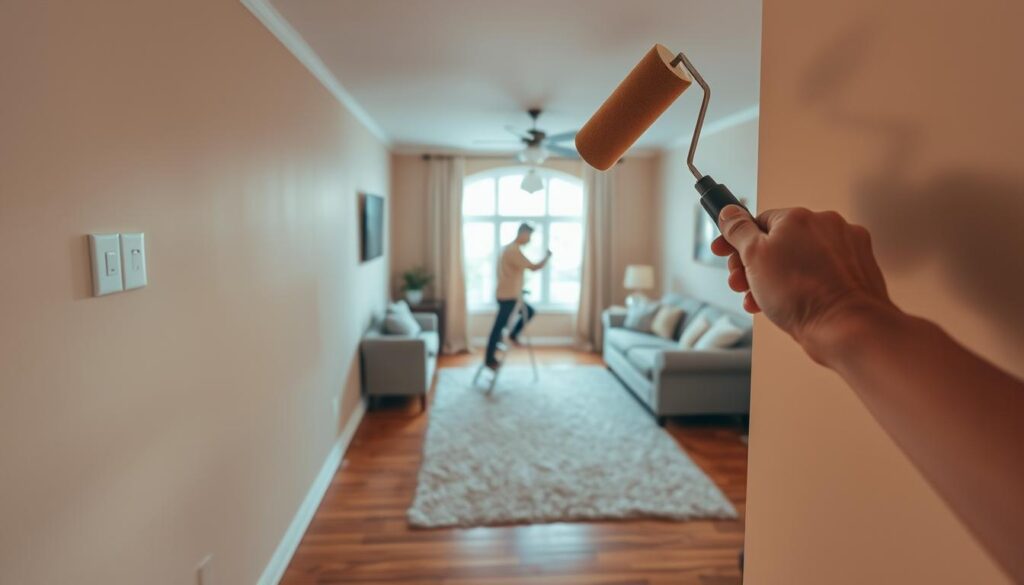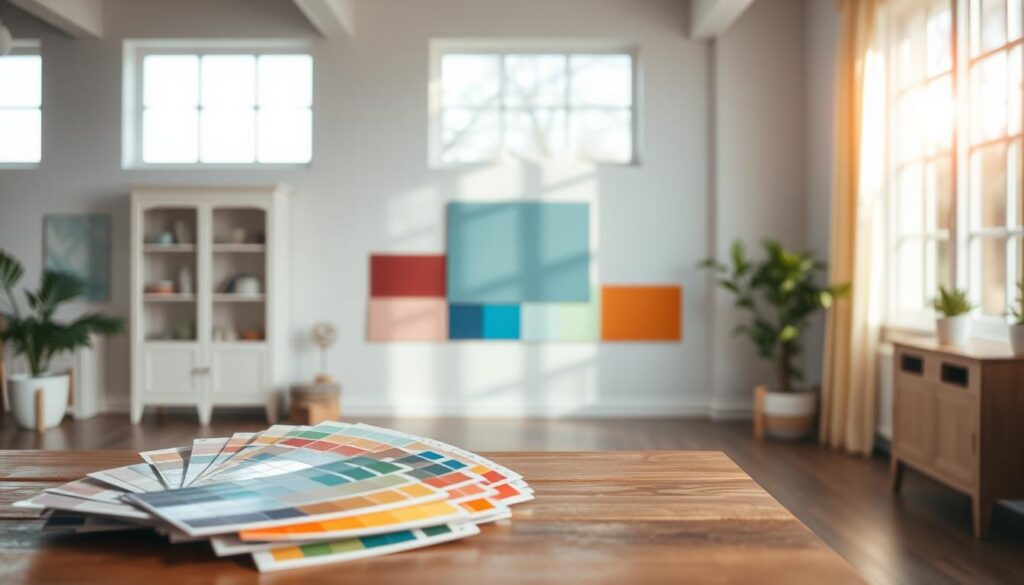Are you wondering how to transform your home’s interior with the perfect wall colour?
Selecting the right paint can be daunting with numerous options available. The correct choice significantly impacts your home’s overall aesthetic and feel.
This comprehensive guide will walk you through the process, covering key factors such as paint composition, room considerations, and application techniques.
Understanding both aesthetic preferences and practical requirements is crucial for different rooms in your home.
Key Takeaways
- Understand the importance of paint composition for durability.
- Consider the specific needs of each room in your home.
- Learn about different paint finishes and their applications.
- Discover how to select colours that enhance your interior.
- Master the techniques for a flawless paint application.
Understanding Paint Basics
To achieve a professional finish, it’s essential to grasp the basic components of paint and their roles. Paint is a mixture of four fundamental ingredients: pigments, binders, solvents, and additives.
What Makes Up Paint?
Pigment gives paint its colour and texture, while the binder holds everything together, determining properties like adhesion and durability. The solvent is the liquid that carries the solid components, allowing the paint to adhere to the surface. Additives enhance various properties, such as stain blocking or mould-killing.
Water-Based vs. Oil-Based Paints
Paints can be broadly classified into water-based and oil-based categories. Water-based paints are easy to clean, dry quickly, and have fewer VOCs, making them kinder to the environment. Oil-based paints, on the other hand, are best suited for metal and wood, offering a smooth finish but taking up to a day to dry.
VOCs and Environmental Considerations
Volatile Organic Compounds (VOCs) are chemicals present in many paint products. Water-based paints generally contain fewer VOCs than oil-based ones, resulting in less odour and a healthier indoor environment when painting your walls. Understanding VOCs is crucial for making an informed decision that balances quality, time, and environmental considerations.
Choosing the Right Paint for Your Walls: Key Factors to Consider
Selecting the perfect paint for your walls involves considering multiple factors that impact both aesthetics and durability. When choosing paint, you need to think about the overall look and feel you want to achieve in your home.
Purpose and Traffic
The purpose of a room significantly influences paint selection. High-traffic areas like hallways and kitchens require more durable, washable finishes compared to low-traffic spaces like formal dining rooms. For instance, a busy kitchen might benefit from a moisture-resistant paint, while a bedroom could be suited to a softer, more calming finish.
Surface Condition
Assessing the existing surface condition is crucial before selecting paint. Identify issues like dampness, cracks, or previous paint types that might affect adhesion and finish quality. This assessment will help you choose the right paint and preparation method.

Durability and Budget
Different areas of your home have different durability requirements. Bathrooms and kitchens need moisture-resistant formulations, while other areas might benefit from scuff-resistant properties. Your budget also plays a significant role; investing in higher-quality paints can provide long-term value despite higher upfront costs.
- Consider the architectural features of a room and how paint can highlight or minimize certain elements.
- Think about how paint can visually impact the perception of space, making rooms appear larger or cozier.
- Align your paint selection with your interior design goals, whether it’s creating focal points or achieving a cohesive flow between rooms.
By considering these factors, you can make an informed decision that enhances the beauty and durability of your walls.
Paint Finishes and Their Best Applications
Selecting the right paint finish is crucial for achieving the desired aesthetic and durability in your home. The finish you choose can significantly impact how the paint looks and performs over time.
Matt Finishes: Elegant and Forgiving
Matt emulsion paint provides a smooth, velvety finish that absorbs light, making it ideal for hiding wall imperfections. It’s particularly suited for living rooms and bedrooms where an elegant, sophisticated look is desired. The matt finish works well in any room style but is especially effective in achieving a classic or period look.
Satin and Silk: The Middle Ground
Satin and silk finishes offer a mid-sheen appearance, reflecting a bit of light while remaining practical. Silk finishes are often used on walls because they’re easy to clean, while satin finishes are commonly applied to woodwork to hide imperfections and give colour a softer appearance.
Eggshell: The Classic Choice
Eggshell finish has a low-luster appearance, sitting between matt and silk finishes. It provides a beautiful, classic look suitable for both walls and woodwork, offering more durability than matt finishes.
Gloss: Bold and Practical
Gloss paint is highly reflective, making it perfect for paler colours and woodwork. While it requires a smooth surface to look its best, gloss finish is hugely practical and adds a lovely contrast to matt walls.
By understanding the characteristics of each paint finish, you can make an informed decision that suits your room’s specific needs.
Selecting the Perfect Colour for Your Space
Selecting a colour that complements your space involves considering several factors, including lighting and room size. The colour you choose can significantly impact the ambiance and overall feel of your room.
How Light Affects Colour Perception
Natural and artificial light can dramatically affect how colours appear on your walls. A colour that looks great in a well-lit, south-facing room may appear entirely different in a darker, north-facing room. Consider the orientation of your windows and how much light they allow into the room throughout the day.

Room Size and Colour Impact
The size of your room is another crucial factor in selecting the right colour. Light colours can make small spaces feel larger, while darker shades can make large rooms feel more intimate and cozy.
Colour Schemes: Contrasting, Monochromatic and Related
There are several approaches to creating a colour scheme. You can use contrasting colours for a dramatic effect, monochromatic colours for a cohesive look, or related colours for a harmonious palette. Each approach can achieve different design objectives and impact the overall style of your space.
Testing Colours Before Committing
Before making a final decision, it’s essential to test the colours. Use sample pots to paint large swatches on your walls and observe how the colours change throughout the day under different lighting conditions. This will help you make an informed decision and ensure the chosen colour enhances the overall feel of your space.
Preparation and Application Essentials
The key to a successful painting project lies in the preparation and application, ensuring a smooth and durable finish. Proper preparation involves more than just picking the right paint; it includes preparing the surface and choosing the right tools for the job.
Primers and Undercoats
Understanding when to use primers and undercoats is crucial. A primer is used as a base coat to help the paint adhere to the surface. It’s particularly useful on new surfaces, during dramatic colour changes, or on problem surfaces. An undercoat, on the other hand, is used to provide a uniform base for the topcoat, ensuring better coverage and a smoother finish. For more detailed guidance on preparing your walls, visit our guide on how to prepare your walls for.
Calculating Paint Quantities
To avoid running out of paint or buying too much, it’s essential to calculate the right quantity. Measure the wall dimensions and consider the surface type, as different surfaces may require more or less paint. Our wall painting calculator can help you determine exactly how much paint you need.
Essential Tools
Having the right tools is vital for a professional-looking result. Essential tools include quality brushes, rollers, extension poles, painter’s tape, and drop cloths. Using the right tools for the job ensures a smooth application and a professional finish on your walls and trim.
- Choose the right primer or undercoat for your project.
- Calculate your paint needs based on wall dimensions and surface type.
- Gather essential tools like quality brushes and rollers.
Conclusion: Making Your Final Decision
As you embark on painting your walls, it’s essential to consider several key factors to ensure a result that meets both your aesthetic and practical needs. The right paint choice can significantly impact the look and feel of your home’s interior. When choosing paint, consider the room’s purpose, traffic, and surface type to select a paint that balances durability with style.
There’s no single “perfect” paint for all situations; the best choice depends on specific room conditions and desired finish. Take your time to test colours and finishes before committing to painting entire walls or rooms. Quality paints offer better coverage, durability, and colour retention, making them a worthwhile investment for most home interior projects.
Approach paint selection as part of a holistic interior design process. With the information from this guide, you’re now equipped to make informed decisions about the right paint for your walls. Experiment with different finishes and colours to develop a personal style that makes your home uniquely reflective of your preferences.



